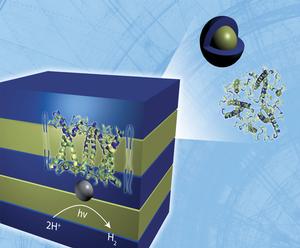Researchers from the US Department of Energy have developed a bio-hybrid system for converting light into hydrogen - a system based on the reaction between photosynthetic plant proteins and synthetic polymers.

Photosynthesis, the natural process carried out by plants, algae and some strains of bacteria, enables the conversion of sunlight energy into chemical energy, and supports most of the life forms found on Earth. For a long time, researchers have been inspired by photosynthesis in order to develop new materials that utilize the sun's energy to produce electricity and fuel.
The researchers from the US Department of Energy are bringing us one step closer to developing a synthetic solar conversion system. They were able to demonstrate, with the help of an advanced laboratory method (small-angle neutron scattering, SANS), that the light-harvesting coupling proteins type II (LHC-II) are able to organize independently together with polymers to obtain the structure of a synthetic membrane and allow the production of hydrogen.
The researchers envision the development of energy-producing light-conversion systems similar to the way plants and other photosynthetic organisms convert light to energy, similar to photovoltaic cells that produce hydrogen fuel.
"Developing a synthetic light-converting system that repairs itself is not an easy challenge. The ability to control the structure and organization of these materials for self-repair is important because similar systems break down over time and lose their effectiveness," explains researcher Hugh O'Neill from the Center for Structural Molecular Biology's laboratory.
"This is the first ever example in scientific history of a protein changing the activity of a synthetic polymer. It will be possible to take advantage of this ability in order to implement self-repair mechanisms in future systems for converting light into electricity," adds the researcher.
The researchers showed that when the coupling is placed in a fatty environment containing the polymers, a reaction occurs between them leading to obtaining thin plate-like surfaces similar to those found in natural photosynthetic membranes.
The ability of the defined coupling (LHC-II) to force the organization of structural polymers into an ordered and multilayered state - instead of a dispersed and disordered state - could lead to the possible development of light-converting bio-hybrid systems. These systems will enable the development of light-receiving glasses with a high surface area that use proteins combined with a catalyst (such as platinum) in order to convert sunlight into hydrogen, which can be used as fuel. The research findings were published in the scientific journal Energy & Environmental Science.

2 תגובות
There cannot be one answer to this question because:
There are at least 4 types of fossil fuels, gas, coal, naphtha and bitumen.
We will not replace all of them in the coming decades, because there is no infrastructure to take advantage of
No other substitute. At most we will replace gas with coal in power plants
(or vice versa) and gas (in a very partial way) in the sun or we will start distilling
bitumen. Another infrastructure simply does not exist and it will take time to build it
Find the factor that can replace the fossil fuels.
The term "worthy" is also problematic. Gasoline (or diesel) in cars is
The most convenient compromise found so far. Any other substitute is
More expensive or toxic or less technologically convenient. but if
The supply of naphtha, from which gasoline and diesel are distilled, will be greatly reduced
And the price ("barrel of oil") will go up a lot. will find a replacement that "deserves a little less"
that will transport cars - such as gas, methanol or electricity, all of which have a superior advantage
Gasoline and diesel in terms of air pollution....and they are all used
Even today, despite their shortcomings, this is also a consolation.
Your question is over..
From one to ten (where one indicates far from the goal and ten means we have reached the goal), how far is the human race currently from finding a suitable energy replacement for fossil fuels?